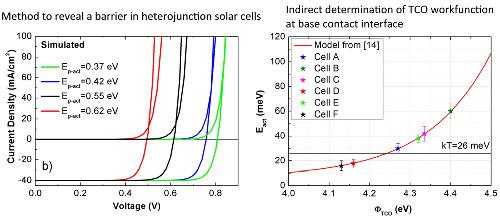当前位置:
X-MOL 学术
›
Prog. Photovoltaics
›
论文详情
Our official English website, www.x-mol.net, welcomes your feedback! (Note: you will need to create a separate account there.)
Selective contacts and fill factor limitations in heterojunction solar cells
Progress in Photovoltaics ( IF 6.7 ) Pub Date : 2021-05-18 , DOI: 10.1002/pip.3418 Luca Serenelli 1 , Luca Martini 1, 2 , Francesca Menchini 1, 2 , Massimo Izzi 1 , Giampiero Cesare 2 , Giuseppe Condorelli 3 , Cosimo Gerardi 3 , Delfina Muñoz 4 , Mario Tucci 1
Progress in Photovoltaics ( IF 6.7 ) Pub Date : 2021-05-18 , DOI: 10.1002/pip.3418 Luca Serenelli 1 , Luca Martini 1, 2 , Francesca Menchini 1, 2 , Massimo Izzi 1 , Giampiero Cesare 2 , Giuseppe Condorelli 3 , Cosimo Gerardi 3 , Delfina Muñoz 4 , Mario Tucci 1
Affiliation

|
Crystalline silicon-based heterojunction (HJ) solar cells are becoming the best choice for manufacturing companies, because of the low temperature processes useful for very thin silicon wafers and the possibility to easily achieve cells efficiencies higher than 22% on n-type silicon wafers. However, the maximum cell efficiency is still limited by the typical Fill Factor (FF) value of 82%. This issue is due to several factors, some of which are sometimes underestimated, like the base contact. Indeed, a potential mismatch between the work functions of the transparent conductive oxide and the base doped layer can give rise to a small barrier against electrons collection, which is not easy to recognize when the cell FF overcomes 80%. Also a low doping efficiency of the p-type amorphous layer at the emitter side can negatively affect the FF. In this case, even if high efficiency cells are produced, their full potential is still unexploited. Thus, both selective contacts of the cell, even if apparently optimized to achieve very good results, can hide problems that limit the final cell FF and efficiency. In a previous work, an experimental method and a model to individuate hidden barriers at the base contact on n-type crystalline silicon-based HJs have been provided. In this paper, that model is applied to experimental data obtained from the characterization of both commercial and laboratory level HJ solar cells. Moreover, an easy method to recognize the presence of a barrier to the charge transport at the emitter side of the cell is illustrated.
中文翻译:

异质结太阳能电池中的选择性接触和填充因子限制
晶体硅基异质结 (HJ) 太阳能电池正成为制造公司的最佳选择,因为低温工艺适用于非常薄的硅片,并且可以轻松实现在 n 型硅片上高于 22% 的电池效率。然而,最大电池效率仍然受到 82% 的典型填充因子 (FF) 值的限制。这个问题是由几个因素造成的,其中一些因素有时会被低估,例如基础接触。事实上,透明导电氧化物和基极掺杂层的功函数之间的潜在失配会产生一个小的电子收集势垒,当电池 FF 超过 80% 时,这不容易识别。此外,发射极侧 p 型非晶层的低掺杂效率会对 FF 产生负面影响。在这种情况下,即使生产出高效电池,其全部潜力仍未得到开发。因此,电池的两个选择性接触,即使明显优化以获得非常好的结果,也可以隐藏限制最终电池FF和效率的问题。在之前的工作中,已经提供了一种在 n 型晶体硅基 HJ 上的基极接触处个体化隐藏障碍的实验方法和模型。在本文中,该模型应用于从商业级和实验室级 HJ 太阳能电池的表征中获得的实验数据。此外,还说明了一种识别电池发射极侧电荷传输势垒存在的简单方法。即使明显优化以取得非常好的结果,也可能隐藏限制最终单元 FF 和效率的问题。在之前的工作中,已经提供了一种在 n 型晶体硅基 HJ 上的基极接触处个体化隐藏障碍的实验方法和模型。在本文中,该模型应用于从商业级和实验室级 HJ 太阳能电池的表征中获得的实验数据。此外,还说明了一种识别电池发射极侧电荷传输势垒存在的简单方法。即使明显优化以取得非常好的结果,也可能隐藏限制最终单元 FF 和效率的问题。在之前的工作中,已经提供了一种在 n 型晶体硅基 HJ 上的基极接触处个体化隐藏障碍的实验方法和模型。在本文中,该模型应用于从商业级和实验室级 HJ 太阳能电池的表征中获得的实验数据。此外,还说明了一种识别电池发射极侧电荷传输势垒存在的简单方法。在本文中,该模型应用于从商业级和实验室级 HJ 太阳能电池的表征中获得的实验数据。此外,还说明了一种识别电池发射极侧电荷传输势垒存在的简单方法。在本文中,该模型应用于从商业级和实验室级 HJ 太阳能电池的表征中获得的实验数据。此外,还说明了一种识别电池发射极侧电荷传输势垒存在的简单方法。
更新日期:2021-07-01
中文翻译:

异质结太阳能电池中的选择性接触和填充因子限制
晶体硅基异质结 (HJ) 太阳能电池正成为制造公司的最佳选择,因为低温工艺适用于非常薄的硅片,并且可以轻松实现在 n 型硅片上高于 22% 的电池效率。然而,最大电池效率仍然受到 82% 的典型填充因子 (FF) 值的限制。这个问题是由几个因素造成的,其中一些因素有时会被低估,例如基础接触。事实上,透明导电氧化物和基极掺杂层的功函数之间的潜在失配会产生一个小的电子收集势垒,当电池 FF 超过 80% 时,这不容易识别。此外,发射极侧 p 型非晶层的低掺杂效率会对 FF 产生负面影响。在这种情况下,即使生产出高效电池,其全部潜力仍未得到开发。因此,电池的两个选择性接触,即使明显优化以获得非常好的结果,也可以隐藏限制最终电池FF和效率的问题。在之前的工作中,已经提供了一种在 n 型晶体硅基 HJ 上的基极接触处个体化隐藏障碍的实验方法和模型。在本文中,该模型应用于从商业级和实验室级 HJ 太阳能电池的表征中获得的实验数据。此外,还说明了一种识别电池发射极侧电荷传输势垒存在的简单方法。即使明显优化以取得非常好的结果,也可能隐藏限制最终单元 FF 和效率的问题。在之前的工作中,已经提供了一种在 n 型晶体硅基 HJ 上的基极接触处个体化隐藏障碍的实验方法和模型。在本文中,该模型应用于从商业级和实验室级 HJ 太阳能电池的表征中获得的实验数据。此外,还说明了一种识别电池发射极侧电荷传输势垒存在的简单方法。即使明显优化以取得非常好的结果,也可能隐藏限制最终单元 FF 和效率的问题。在之前的工作中,已经提供了一种在 n 型晶体硅基 HJ 上的基极接触处个体化隐藏障碍的实验方法和模型。在本文中,该模型应用于从商业级和实验室级 HJ 太阳能电池的表征中获得的实验数据。此外,还说明了一种识别电池发射极侧电荷传输势垒存在的简单方法。在本文中,该模型应用于从商业级和实验室级 HJ 太阳能电池的表征中获得的实验数据。此外,还说明了一种识别电池发射极侧电荷传输势垒存在的简单方法。在本文中,该模型应用于从商业级和实验室级 HJ 太阳能电池的表征中获得的实验数据。此外,还说明了一种识别电池发射极侧电荷传输势垒存在的简单方法。



























 京公网安备 11010802027423号
京公网安备 11010802027423号